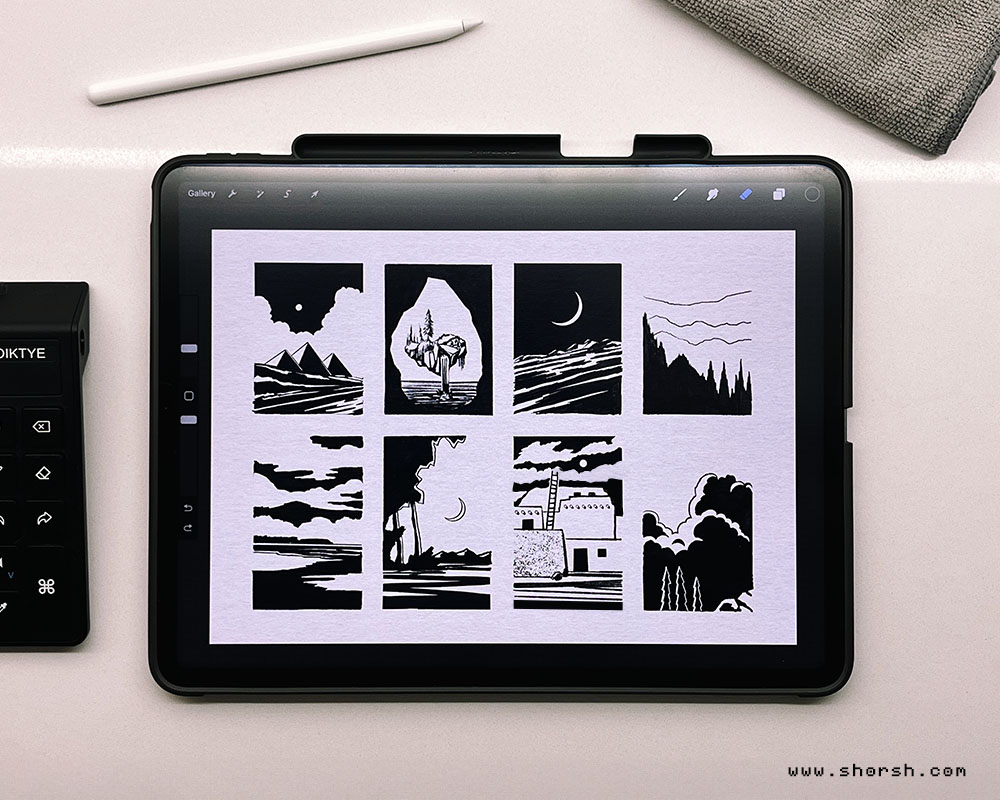When it comes to artistic exploration, I really enjoy notan thumbnail sketching. These miniature wonders, born from the nimble strokes of a pen, pencil, marker or brush, hold the power to visualize, simplify, and decode the complex dance of light and dark in the visual world. Notan sketching can really transform your artistic process.
So, why make thumbnail sketches when we can just take a quick photograph?
A photograph captures indiscriminately, but notan thumbnail sketching demands choice. It’s the artist’s decision-making in action—a journey from the real-world profusion to a 2D design, a decoding of scenes into simplified blocks of visual information. Thumbnails force us to decide what is most important, to eliminate the superfluous, and to take the first step in the creation of a work of art—simplification and massing.
Their Purpose: Memory Aid and Planning Tool
Notan Thumbnails are not just sketches; they are memory aids and planning tools. Firstly they crystallize the initial excitement, helping us remember the essence of a scene or artwork and why it fascinated us. Secondly, they are companions in museums, capturing paintings we adore. Thirdly, they serve as a canvas for experimenting with multiple compositions, recognizing that the first one is rarely the best.
How They’re Crafted: From Flash to Sketch
Hold in your mind that initial flash of excitement. Jot down a word or two about that feeling. Draw a rough rectangle, outline major shapes, ignore details, squint to see only the big shapes. Imagine it as a painting. Try variations, learning and improving from sketch to sketch. Establish the location of major elements, and let the sketches evolve, just by blocking the most important shapes in black. Shadows are dark, highlights remain white.
Useful Notes: Capturing the Experience
Begin with the emotional content— the shape of trees emerging mysteriously from fog, majestic mountains scraping the sky, a magical alpine glow, light flowing across from left to right. Capture relationships, contrasts, weather, sounds, smells—anything that might bring back the experience.
Why Bother?: Because Thumbnails Save Time and Improve Paintings
While it might seem tempting to jump straight into painting, the power of thumbnails lies in their ability to save time and enhance the final masterpiece. They refine the artist’s vision, ensuring that every stroke contributes to a stronger composition.
Notan Thumbnails: The Light and Dark Symphony
When used in paintings, a Notan drawing becomes the underlying light and dark structure. Seeing Notan involves identifying patterns of light and dark. A good Notan drawing simplifies a subject’s full range of values into a black and white design, where white represents areas in direct light and black depicts areas in shadow.
The ‘Notan’ Origin: A Japanese Design Concept
The term ‘Notan’ finds its roots in a Japanese design concept—playing and placing light and dark next to each other. It translates shape and form into flat, two-dimensional surfaces. Traditionally presented in paint, ink, or cut paper, Notan is relevant to modern image-making techniques.
Creating Notan Sketches in the Digital Space
You can create efective Notans using Photoshop or even Procreate. Start with a photo, convert it to grayscale, and posterize with 2 or 3 colors. Edit and apply curves to explore contrast and color options easily. The digital canvas becomes a playground for Notan exploration, adding a new dimension to your artistic toolkit.
As you embark on your Notan journey, remember that these sketches are more than visual aids—they are portals to stronger compositions and refined artistic visions. Let your thumbnails illuminate the path to artistic mastery, and may the dance of light and dark guide you to new heights in your creative odyssey.

Leave a Reply